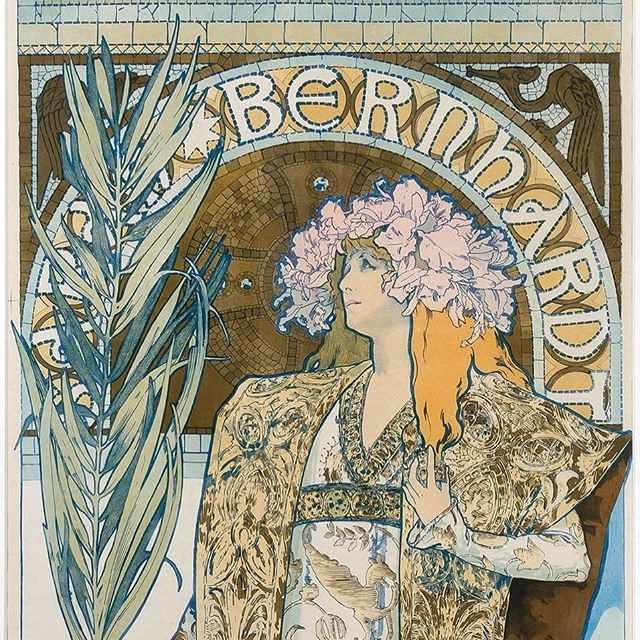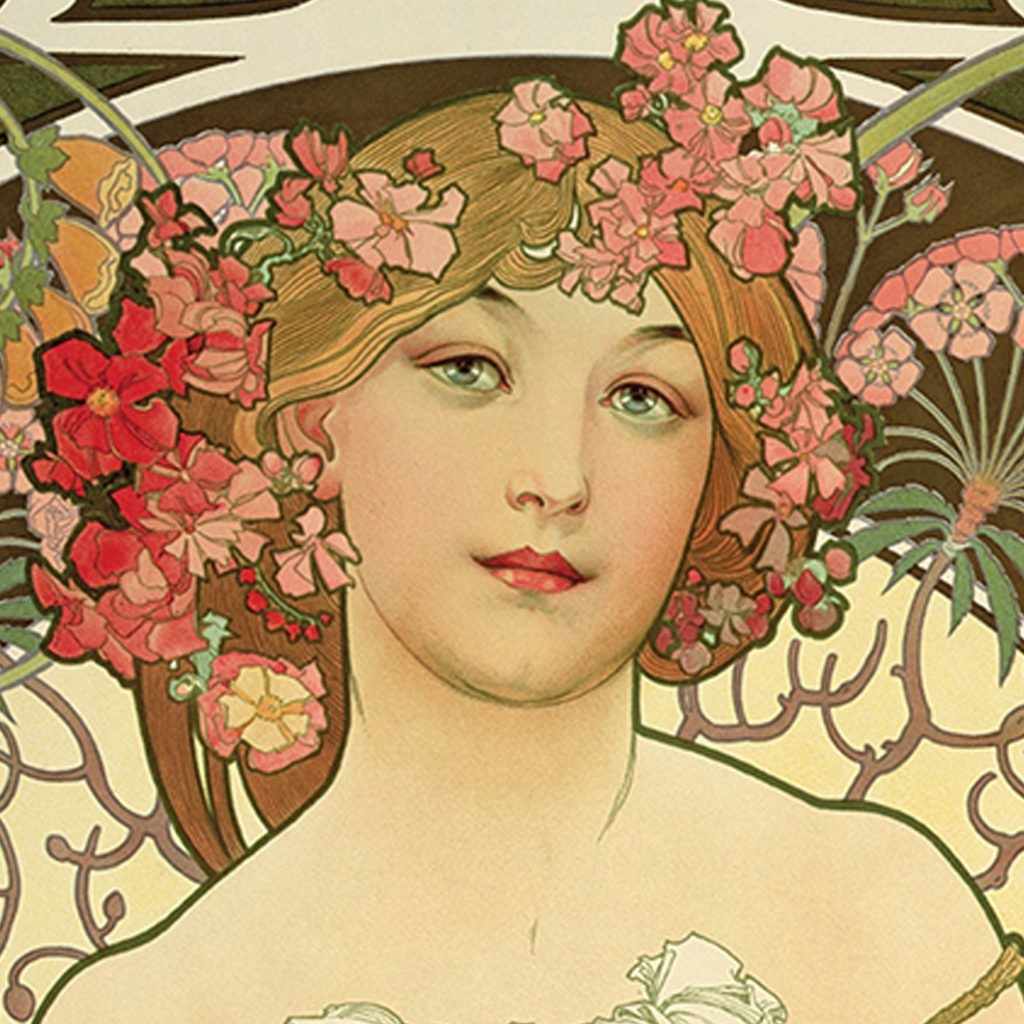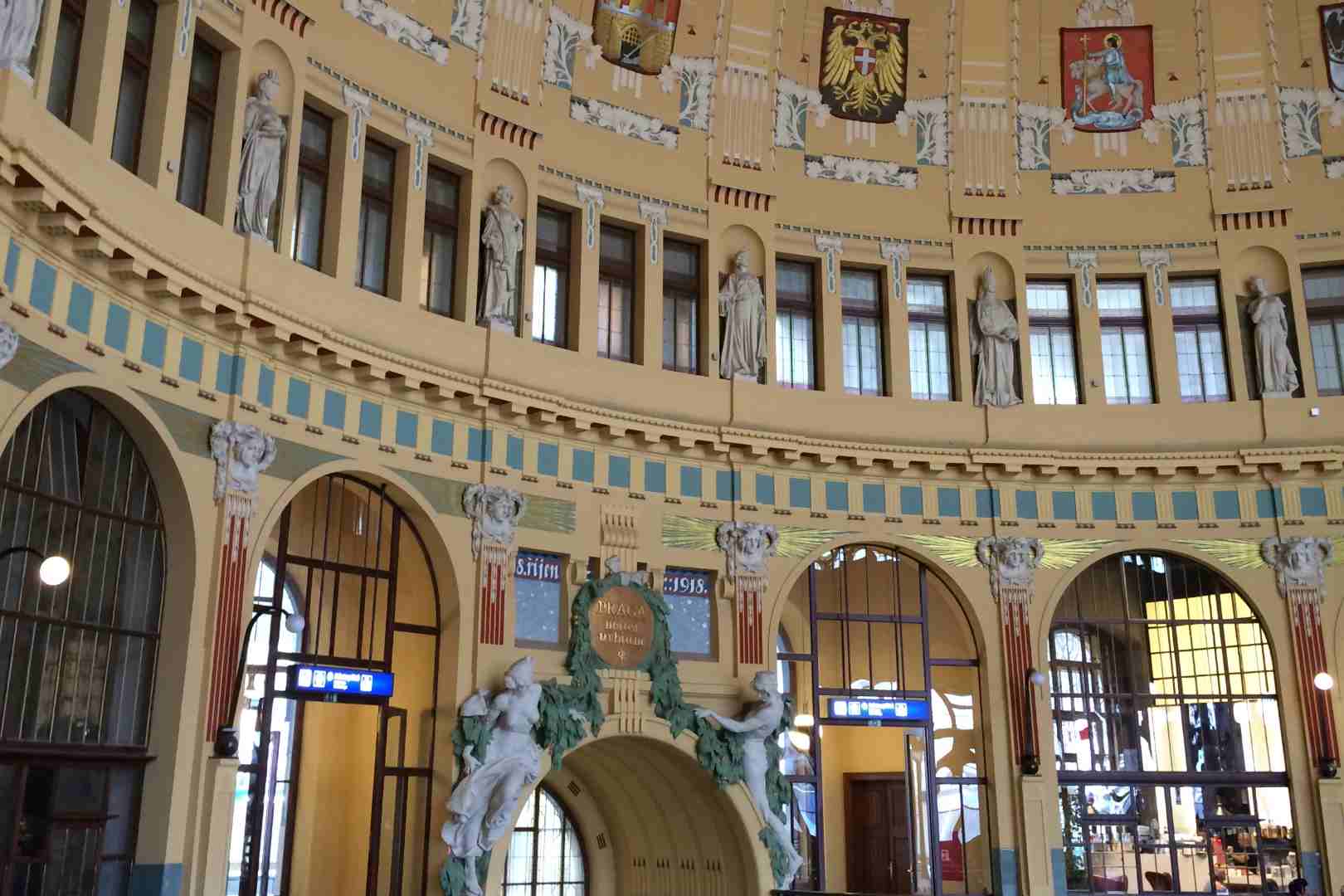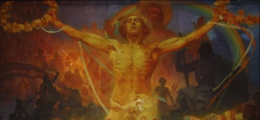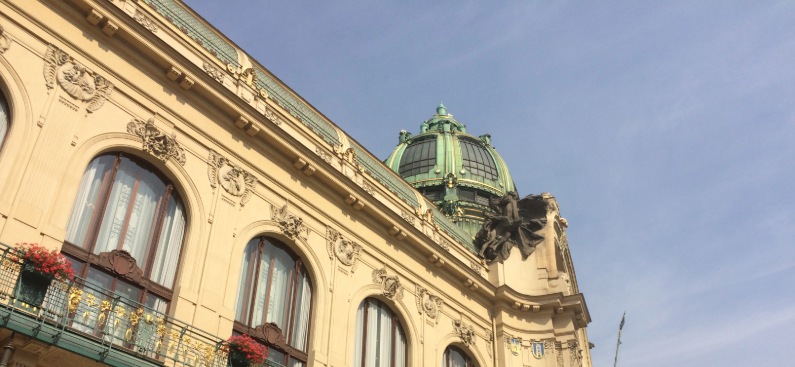Alphonse Mucha’s depiction of women, seen in everything from commercial posters to stained glass, captures a sense of power and beauty that transcends mere physical allure. These figures, central to his distinctive Art Nouveau style, project an ethereal elegance without being overtly sexualized.
But who are these women in Mucha’s art? Interestingly, today’s focus isn’t on the personal life or romantic affairs of the artist—Mucha was deeply devoted to his wife, with whom he shared both joys and struggles. Instead, we delve into the world of his artistic creations, where his women became iconic symbols of the era.
Mucha’s art saturates the city, appearing on posters, advertisements, canvases, and even within the majestic stained glass windows of St. Vitus Cathedral. These women seem to be everywhere, witnessing the daily lives of people in the heart of the city, both day and night.
What makes these women so striking is not just their beauty, but the power they radiate. They possess a timeless grace, an almost mystical aura that is unmistakable. Alphonse Mucha had a unique way of portraying them that never felt exploitative or objectifying. Rather than focusing on their sensuality, Mucha elevated their presence, infusing them with strength and dignity. They weren’t simply muses or decorative figures—they were embodiments of power wrapped in beauty.
Mucha’s talents were multifaceted. While primarily known as a painter, he was also a theatrical set designer, illustrator, jewelry maker, and poster creator. His works spanned a wide array of mediums, which helped cement his legacy as a central figure in the Art Nouveau movement. Art Nouveau, which flourished across Europe at the turn of the 20th century, was characterized by its flowing, organic lines, intricate details, and floral motifs. Mucha was at the forefront of this movement, using his artistry to blur the rigid lines of traditional academic art.
In addition to his fine art, Mucha’s commercial work—creating posters and advertisements—helped him reach an even broader audience. His posters for theatre productions, as well as his advertisements for everything from champagne and cigarettes to chocolates and perfumes, are now iconic pieces of the Art Nouveau era. These works, much like his more personal creations, feature the same empowered and graceful women, showcasing Mucha’s ability to blend commercial appeal with timeless beauty.
Ultimately, Mucha wasn’t just an artist—he was a visionary who saw beauty in a way that went beyond the surface, redefining how women could be depicted in art. His influence helped shape the aesthetics of his time, and his portrayal of women continues to resonate today as symbols of both strength and elegance.
Alphonse Mucha’s widespread appeal and lasting popularity can be largely attributed to the constant visibility of his work in public spaces, particularly through advertising. He had a deep conviction that advertisements should not only serve a commercial purpose but also be works of art in their own right. This belief shaped his approach to commercial art, blending beauty with marketing in a way that captivated society. One iconic example of this is his famous poster created for “Job” cigarette paper.
In this piece, the central figure—a striking woman—is not just selling a product but embodying a sense of grace and freedom. The smoke, which gently curls around her, is not the focal point but rather a decorative element that enhances the overall composition. It complements the figure without overpowering her presence. Her flowing, unbound hair, even more liberated than the smoke, breaks away from traditional portrayals of women at the time, where restraint and decorum were often emphasized. This contrast between the delicate wisps of smoke and the dynamic movement of her hair symbolizes a new sense of freedom and modernity in Mucha’s portrayal of women.
Mucha’s attention to detail is also evident in the poster’s design elements. The frame, reminiscent of Byzantine mosaics, is a nod to classical artistry, while the luxurious interplay of gold and purple adds an air of exclusivity and sophistication. This combination of rich colors and ornate design suggests that the product being advertised is not merely an everyday item, but something with an aura of elegance and refinement.
However, it wasn’t just the beauty of the design that caused a stir. The fact that the woman in the poster is smoking—a behavior often reserved for men in that era—challenged societal norms. Mucha’s portrayal of a woman enjoying a cigarette was, at the time, a bold and scandalous statement. Far from being a passive or submissive figure, she is confident, empowered, and independent. Her unapologetic act of smoking in the poster suggested strength and autonomy, qualities that were not typically associated with women in advertisements during that period.
This particular image, with its combination of luxurious detail and subversive elements, didn’t just sell a product—it contributed to shifting cultural perceptions. By presenting women in a more empowered and liberated light, Mucha played a role in challenging traditional gender roles and expectations. His work transcended the commercial realm, influencing both art and society.
In this way, Mucha’s advertising was revolutionary. He not only elevated the medium by treating posters and advertisements as legitimate forms of art but also pushed the boundaries of how women could be depicted in the public eye. His creations were memorable and culturally significant, using beauty and grace to subtly provoke and question societal norms. As a result, Mucha’s works left an indelible mark on both the art world and the evolving perceptions of women in society.
The Precious Stones (1900)
In 1900, Alphonse Mucha introduced his stunning series Precious Stones, where he brought four gemstones—ruby, amethyst, emerald, and topaz—to life through the medium of art. Mucha didn’t simply paint these stones as inanimate objects; instead, he infused them with human qualities, transforming each stone into a female figure whose pose, facial expression, and surrounding ornamentation reflect the unique character and symbolism of the gem she represents.
Each canvas in the Precious Stones series radiates the essence of its respective stone. The women in these works are more than mere muses; they embody the spirit of the gemstones. Mucha, known for his mastery of Art Nouveau, surrounds each woman with intricate floral and natural motifs, characteristic of the organic and flowing lines of the movement. These natural elements not only enhance the visual appeal but also help convey the deeper meaning behind each stone’s symbolism.
Rather than elevating one stone above the others, Mucha treats them with equal reverence, allowing each woman—and the stone she represents—to stand on her own. The ruby, with its bold and commanding presence, is depicted seated regally on a throne, exuding an air of authority and power. Meanwhile, the amethyst gazes directly at the viewer, making strong eye contact that suggests a connection between the stone and the observer. This interaction draws the viewer into the scene, highlighting the stone’s association with clarity of thought and wisdom.
One of the most striking elements in the Amethyst painting is the inclusion of a snake, a traditional symbol of wisdom, coiled gracefully around the figure. The snake not only personifies the gemstone’s symbolic connection to knowledge and insight but also adds a mystical, almost otherworldly quality to the scene. Mucha’s careful attention to these symbolic details ensures that each gemstone’s inherent power is expressed through the strength and elegance of the women who represent them.
Mucha’s Precious Stones series goes beyond mere decorative art. The strength of each gemstone is conveyed not only through the luminous colors and delicate design but also through the commanding presence of the women themselves. These women do not simply adorn the stones—they are the stones, and their inner strength reflects the symbolic power of the jewels they represent. Their poses, from the ruby’s regal composure to the amethyst’s steady gaze, imbue the pieces with a sense of energy and vitality, making the stones feel almost alive.
What makes the series particularly captivating is how Mucha merges his signature style with the symbolism of the gemstones. By placing the women at the center of these elaborate, jewel-toned compositions, he draws attention not only to the beauty of the stones but also to the intrinsic qualities they represent—strength, wisdom, elegance, and resilience. Every detail in these works is thoughtfully designed, from the soft, flowing lines of the women’s hair to the intricate floral patterns that envelop them, creating an atmosphere of luxury and mysticism.
Through the Precious Stones series, Mucha once again demonstrates his mastery of symbolism and his ability to transcend traditional boundaries in art. His work captures the timeless connection between beauty and power, using the natural world as both a source of inspiration and a medium to convey deeper truths. Each canvas becomes more than just a celebration of gemstones—it is an exploration of the profound qualities that these stones have embodied throughout history, all reflected through the strength and allure of the women who bring them to life.
Zodiaque (“La Plume”)
La Plume Zodiaque, created as a calendar for a French magazine in 1896, quickly became one of Alphonse Mucha’s most iconic works. The piece was designed with both aesthetic and practical purposes in mind, yet it transcended its function to become a celebrated symbol of Mucha’s mastery of Art Nouveau. The popularity of Zodiaque soared, and it’s easy to see why—this image, with its intricate details and celestial theme, became synonymous with Mucha’s artistic vision and can still be found in countless reproductions.
At the center of La Plume Zodiaque, we find a woman portrayed in profile, her face serene and composed, surrounded by the 12 zodiac signs forming a glowing halo around her head. This arrangement immediately draws attention to the woman, positioning her not just as a mere figure but as a representation of something much greater. The zodiac, often linked to mysticism and astrology, adds a sense of cosmic importance to the scene, as though the woman herself embodies the universe. Her poised demeanor, framed by luxurious jewelry and ornate detail, conveys both elegance and a sense of inevitability, as if she carries the weight of fate within her gaze.
The zodiac is a recurring motif in Mucha’s work, symbolizing life’s cyclical nature and the desire to understand, predict, and perhaps control the course of events. In La Plume Zodiaque, the zodiac takes on a life of its own, wrapping around the woman like a crown, emphasizing her role as not just a subject, but as the embodiment of cosmic forces. This portrayal adds layers of meaning to the image: the woman is more than a symbol of beauty—she is the universe itself, intertwined with the mysteries of life and time.
One of the reasons Mucha’s works, including La Plume Zodiaque, have endured in their popularity is his portrayal of women as powerful, enigmatic figures. Mucha didn’t simply create beautiful images; he infused them with energy, treating his female subjects as something more than passive figures or objects of desire. In his art, the woman is elevated—she is not only the zodiac but also the ruby, the smoke, the champagne, and even the very essence of Prague itself. By blending beauty with deeper symbolism, Mucha seemed to capture the ineffable nature of a woman’s energy, making it both mysterious and universal.
Perhaps this is where Mucha’s true success lies—his ability to tap into something profound and eternal. The women in his works are not bound by the traditional depictions of femininity from his time. Instead, they radiate an almost otherworldly force, hinting at something deeper and more mystical. This enigmatic quality resonates with viewers, drawing them in not only because of the warm colors and intricate designs but because of the underlying sense of power and mystery that each figure embodies.
There’s something universal about Mucha’s portrayal of women that goes beyond mere aesthetics. His art doesn’t simply highlight beauty for beauty’s sake; it connects that beauty to larger forces—fate, time, and the natural world. His work invites contemplation about the roles of women, not as objects, but as embodiments of larger truths. Mucha seemed to understand that there’s something unknowable and untamable about feminine energy, and this is reflected in his work. He painted women not just as individuals, but as symbols of something greater—the zodiac that governs life, the stones that represent strength, the smoke that lingers in the air after a fleeting moment.
Perhaps this is why his work continues to resonate. While some might simply enjoy the vibrant colors, the flowing lines, or the Art Nouveau style that Mucha mastered, there’s an undeniable depth to his portrayal of women that sets his art apart. It invites viewers to see more than what’s on the surface—to recognize the layers of symbolism and meaning that elevate these figures to something almost divine. And yet, there’s still room for interpretation. What makes Mucha’s work so intriguing is that while he gives us these powerful, beautiful women, he leaves space for us to wonder: are they queens of the universe, or simply a reflection of life’s mysterious energy?
In the end, Mucha’s success might stem from the fact that his art operates on multiple levels. For some, it’s the aesthetic appeal of the warm colors, the flowing lines, and the intricate details that captivate. For others, it’s the deeper symbolism and the way Mucha portrayed women as embodiments of life’s greater forces. Whatever the reason, it’s clear that his work taps into something timeless, something that continues to draw people in more than a century after it was created. But as you mentioned, there’s still room for confusion—what do you think? Is it the beauty, the energy, or the mystery that makes Mucha’s art so enduringly captivating?
Walking through Prague, you’ll encounter exquisite Art Nouveau buildings, each with unique details. These architectural gems showcase the city’s commitment to preserving its history. Discover more about these sites here.
We’d like you to read about Sarah in the page of the private tour that we have dedicated to her. See it HERE and enjoy the reading.
Paris and Prague each celebrate Alphonse Mucha’s legacy, with both cities claiming a significant role in the artist’s life and work.

